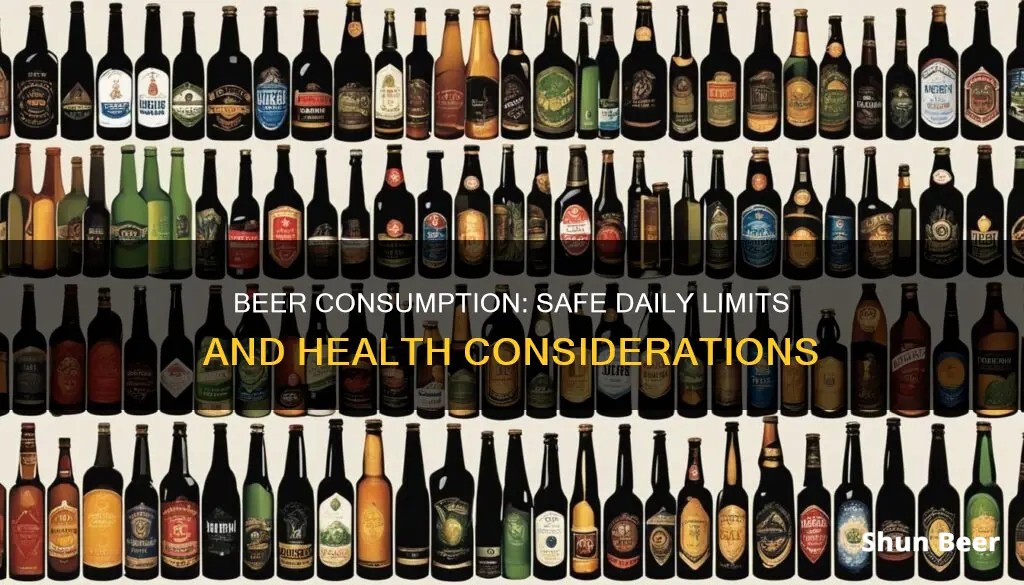
Beer is a drink made by fermenting sugars from starches. It can be alcoholic or non-alcoholic. While some studies suggest that moderate drinking may be linked to certain health benefits, other research shows no such benefits and links moderate drinking to diseases like breast cancer and an increased risk of stroke.
According to the National Institute on Alcohol Abuse and Alcoholism (NIAAA), the upper limit for healthy adults is four drinks in one day or 14 per week for men, and three drinks in one day or seven per week for women. Drinking more than these amounts is considered heavy or at-risk drinking and puts one at a higher risk of developing health problems.
In addition, drinking too much too quickly on any single occasion can increase the risk of accidents, misjudging risky situations, and losing self-control. It is recommended to limit alcohol intake, alternate with water or non-alcoholic drinks, and have several drink-free days each week.
| Characteristics | Values |
|---|---|
| Number of drinks considered "too much" for men per day/week | 4 drinks in one day or 14 per week |
| Number of drinks considered "too much" for women per day/week | 3 drinks in one day or 7 per week |
| Number of drinks considered "binge drinking" for men | 5 or more "standard" drinks in 2 hours |
| Number of drinks considered "binge drinking" for women | 4 or more "standard" drinks in 2 hours |
| Number of drinks considered "heavy drinking" for men per day/week | 5 or more drinks on any day or 15 or more per week |
| Number of drinks considered "heavy drinking" for women per day/week | 4 or more drinks on any day or 8 or more per week |
| Number of drinks considered "low-risk drinking" per week | Less than 14 units a week |
What You'll Learn

What is a 'standard' drink?
In the United States, a "standard drink" is defined as any beverage containing 0.6 fluid ounces or 14 grams of pure alcohol. This is usually the amount in 12 fluid ounces of regular beer, 5 fluid ounces of wine, or 1.5 fluid ounces of distilled spirits. However, it's important to note that different types and brands of alcoholic beverages can contain varying amounts of alcohol. For example, some microbrews and craft beers have higher alcohol content than regular beer. Therefore, when determining how much alcohol you're consuming, it's crucial to consider both the volume of the drink and its alcohol content.
In the context of health guidelines, a standard drink is a useful measure for understanding safe drinking limits. According to these guidelines, men should not exceed four drinks in a day or 14 drinks per week, while women should limit their intake to three drinks in a day or seven drinks per week. Exceeding these limits is considered heavy or at-risk drinking and increases the likelihood of developing health problems and alcohol use disorders.
It's worth noting that the definition of a standard drink and the associated health guidelines may vary across different countries and regions. Additionally, individual circumstances, such as age, gender, weight, and medical conditions, can also influence safe drinking limits. It's always advisable to consult with a healthcare professional for personalized advice regarding alcohol consumption.
The Magic of Beer: Trapping Pests with Fermentation
You may want to see also

How much is too much?
While there is no "safe" drinking level, drinking less than 14 units of alcohol a week is considered low-risk. This is not the same as "safe", as even low levels of drinking are linked to certain types of cancer, including mouth, throat, and breast cancer.
In the United States, a "standard" drink contains about 14 grams of pure alcohol. This is roughly equivalent to:
- 12 ounces of regular beer (5% alcohol)
- 5 ounces of wine (12% alcohol)
- 1.5 ounces of distilled spirits (40% alcohol)
According to the National Institute on Alcohol Abuse and Alcoholism (NIAAA), drinking more than the following amounts is considered "heavy" or "at-risk" drinking:
- Men: Four drinks in one day or 14 per week
- Women: Three drinks in one day or seven per week
Drinking at this level is associated with a higher risk of developing health problems, including liver disease, alcohol use disorder, and certain types of cancer. It is recommended that adults of legal drinking age limit their intake to two drinks or less per day for men and one drink or less per day for women.
Binge drinking is defined as consuming enough alcohol to raise your blood alcohol concentration (BAC) to 0.08% or higher. This typically occurs when men consume five or more drinks or women consume four or more drinks within about two hours. Binge drinking is associated with more than half of the alcohol-related deaths in the United States and increases the risk of accidents, memory blackouts, medication interactions, assaults, and overdose deaths.
It is important to note that the effects of alcohol on your health depend on various factors, including how much you drink, how often you drink, your body weight and composition, and any underlying medical conditions. If you are concerned about your drinking habits, it is always best to consult with a healthcare professional.
Beer in Baking: The Secret to Perfect Crusts and Doughs
You may want to see also

What are the health risks?
While drinking alcohol in moderation has been linked to certain health benefits, such as improved memory and thinking skills in older males, and a reduced risk of heart disease, congestive heart failure, type 2 diabetes, and certain infections, excessive alcohol consumption is associated with a range of health risks. These risks include:
- Liver problems: Alcoholic beverages contain ethanol, which is broken down in the liver by the enzyme alcohol dehydrogenase (ADH). Chronic heavy drinking can lead to inflammation of the liver (alcoholic hepatitis) and, in the long term, may cause scarring of the liver (cirrhosis), which can be life-threatening.
- Cardiovascular issues: While moderate drinking may reduce the risk of cardiovascular disease, excessive alcohol consumption can have the opposite effect. Heavy drinking increases the risk of heart disease and stroke.
- High blood pressure: Drinking more than three alcoholic beverages per day can increase blood pressure and worsen hypertension.
- Cancer: Excessive alcohol consumption has been linked to an increased risk of various cancers, including mouth cancer, throat cancer, breast cancer, and head and neck cancer.
- Mental health issues: Regular drinking at high-risk levels can negatively affect mental health. Research has found strong links between alcohol misuse and self-harm, including suicide.
- Neurological conditions: Excessive alcohol consumption can worsen neurological conditions and increase the risk of seizures in individuals taking certain medications, such as phenytoin.
- Dependence and addiction: Long-term excessive alcohol consumption can lead to alcohol dependence and alcohol use disorder (AUD). AUD is characterised by an impaired ability to stop or control alcohol use despite adverse consequences.
- Other health issues: Excessive drinking can cause blackouts, drowsiness, low blood sugar, vomiting, and other serious problems. It can also worsen conditions such as gout, insomnia, and stomach ulcers.
Longmire's Beer Choice: What Walt Drinks and Why
You may want to see also

Who should avoid alcohol completely?
According to the World Health Organization, there is no safe amount of alcohol consumption that does not affect health. Alcohol is a toxic, psychoactive, and dependence-producing substance and has been classified as a Group 1 carcinogen. It causes at least seven types of cancer, including bowel and breast cancer. The risk of developing cancer increases with the amount of alcohol consumed. However, half of all alcohol-attributable cancers in the WHO European Region are caused by "light" and "moderate" alcohol consumption.
Therefore, individuals who are planning to drive or operate machinery, taking medications that interact with alcohol, living with a medical condition that alcohol can worsen, or pregnant or trying to conceive should avoid alcohol completely.
Additionally, people who are dependent on alcohol or have medical or mental health issues should refrain from drinking. Seeking professional help from a doctor, counsellor, or therapist can be beneficial for those struggling to quit.
Beer Drinking Post-Whipple: What You Need to Know
You may want to see also

What is binge drinking?
Binge drinking is a pattern of drinking large amounts of alcohol in a short period of time. It is defined as consuming enough alcohol to reach a blood alcohol concentration (BAC) of 0.08% or higher. This typically means drinking four or more drinks for women and five or more drinks for men within about two hours. Binge drinking is the most common form of excessive drinking and is responsible for a significant number of alcohol-related deaths and costs in the United States. It increases the risk of acute harm, such as blackouts, overdoses, unsafe sexual behaviour, and unintentional injuries. Additionally, it can lead to long-term health problems, including liver disease, heart problems, and an increased risk of several types of cancer.
Binge drinking is determined by the amount of alcohol consumed relative to one's blood alcohol concentration, rather than the type of alcohol consumed. In the United States, a "standard" drink contains about 14 grams of pure alcohol, which is typically found in 12 ounces of regular beer, 5 ounces of wine, or 1.5 ounces of distilled spirits. However, it is important to note that different types and brands of alcoholic beverages can vary in their alcohol content. Therefore, it is essential to be mindful of the alcohol content when consuming different drinks.
The National Institute on Alcohol Abuse and Alcoholism (NIAAA) provides a definition of binge drinking based on BAC levels, while the Substance Abuse and Mental Health Services Administration (SAMHSA) defines it as consuming four or more drinks for women or five or more drinks for men on the same occasion on at least one day in the past 30 days. This discrepancy highlights the need for clear and consistent guidelines regarding binge drinking.
Binge drinking is a serious issue, particularly among certain demographics. According to statistics, about 1 in 4 American adults engage in binge drinking at least once a year, and it is more prevalent among adults under 35 and men. Additionally, people with higher incomes and education levels are more likely to binge drink. Understanding the risks and consequences of binge drinking is crucial for promoting responsible alcohol consumption and preventing alcohol-related harm.
Beer and Lemon: A Refreshing Mix?
You may want to see also
Frequently asked questions
There is no "safe" drinking level, but there are weekly "upper limits" for healthy adults. Men should not exceed four drinks in one day or 14 per week, and women should not exceed three drinks in one day or seven per week. If you drink more than these amounts, doctors consider that "heavy" or "at-risk" drinking.
Drinking too much beer can damage your liver, causing inflammation (alcoholic hepatitis) and potentially leading to life-threatening scarring (cirrhosis). It can also increase your risk of stroke, damage your heart muscle (cardiomyopathy), and raise your blood pressure. In addition, drinking too much beer has been linked to several types of cancer, including mouth, throat, and breast cancer.
If you find yourself drinking more than the recommended limits, experiencing negative consequences from your drinking, or struggling to control your alcohol intake, these may be signs that you're drinking too much beer. It's important to be aware of the health risks associated with excessive alcohol consumption and to seek help if you're concerned about your drinking habits.







